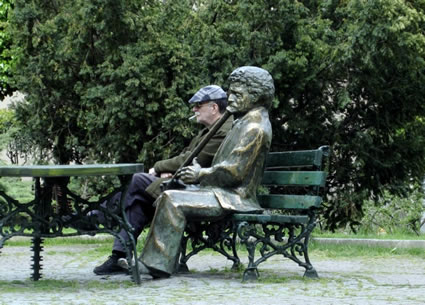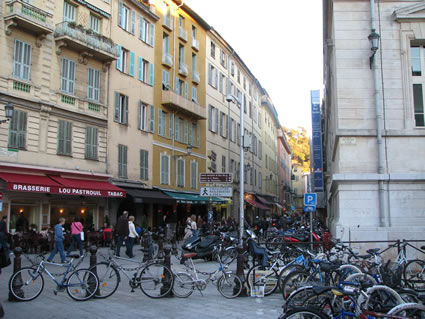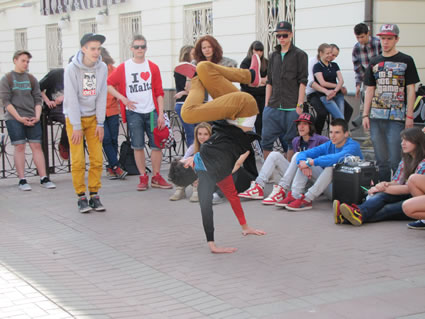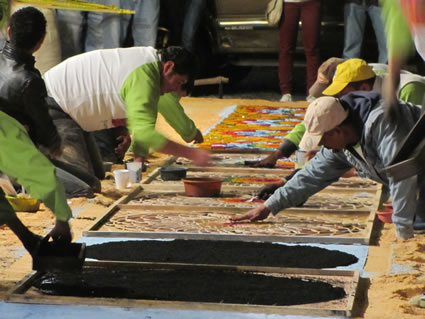For many fellow travelers, “experiencing
another culture,” means something far different from visiting
museums, archeological ruins, and national monuments. While
trying to visit the Pyramids and Colosseums of the world,
these ancient icons do little in the way of illuminating
the culture in another country. It is precisely everyday
life — modern, messy, and malleable–that often interests me
most.
I’ve heard droves of other travelers
and expats say it as well: I want to experience other cultures.
However, how does one go about doing so? After nearly a
decade of living abroad, both as a traveler and a working
expat, I’ve come up with a few ideas about what makes me
feel most immersed in different worlds.
1) Move
Slowly: I recommend spending more time in
one place rather than checking as many off the proverbial
list as possible. Having nothing in particular to
do often reveals much more about a place and culture
than following an all-encompassing itinerary.
Imagine summing up your hometown
with a dozen landmarks over two or three days. While
it might offer some sense of history, it does little
in the way of explaining everyday life. Life comes while
sitting idly over breakfast at a regular café, going
to the neighborhood supermarket for some sugar, and having
a favorite bench to read a book on. Sometimes the big
attractions are part of people’s life, but they don’t
encapsulate it. Be cautious about treating a place like
a highlight reel. There is a lot of culture lurking between
the most known locations.

|
|
Istanbul — Parks have a way
of illuminating the nature of people around you
as well. I love this shot of a man smoking next
to his buddy on a bench in Taksim Park.
|
2) Rent an Apartment:
Nothing says “from out of town” like staying in a hotel
or hostel, and nothing says “my town” like twirling around
a set of keys to your own apartment. Luckily, it’s easy
enough to rent
short-term just about anywhere in the world.
I like hostels, the backpacker in
me can’t help it, but I end up hanging out at the hostel
with other travelers. It’s great for travel tips but
often impedes exposing me to where I am. I’ll never forget
Mommy, my Korean landlady who was well past grandmother
age. Mommy didn’t understand that I wasn’t her child,
couldn’t speak Korean, and locked my door for a reason.
She had her own key and her own way of presenting me
with whatever new resident perk she’d contrived: a free
bag of rice cakes, a new washing machine, or just some
conversation while I stood in my underwear confused.
* Homestays are another
option. As a vegetarian (perhaps one of the least popular
diets in some countries around the world), a beer-enthusiast,
and a sometimes-moody character, I prefer not to subject
hosts to my unique needs. It’s important to consider
others when doing a homestay, and in doing so, I’ve
decided renting an apartment is a better option for me.

|
|
Rent an apartment in old Nice in October for a fraction of the going rate during high season and cook your own food from the great markets nearby, or just hang out and people-watch from the busy cafes.
Photo © Transitions Abroad.
|
3) The Food Market:
What people eat explains a great deal about a society,
the landscape, the environment of a country, the aesthetics,
the rituals, as well as the general outlook on life.
A traditional dish at a restaurant sometimes hardly begins
to explain how a grandma goes about compiling the ingredients
to make it (unless grandma is the cook).
I find a regular stall at the nearest
fruit and vegetable market to my apartment. After two
or three visits, the seller recognizes me, and this leads
to a deeper exposure. For example, in Moscow, after learning
that pickles feature heavily in the local cuisine, I
befriended “a pickle lady” at the neighborhood market.
Every visit, she’d give me two or three new things to
sample, different versions of the pickled cabbage I’d
previously purchased, or another type of pickled pepper.
Then, as I paid for the food, she’d throw in a couple
of extras for me to try — her favorites. How local is that?
4) Public
Transportation: It’s in the very name, "public
transportation." Traveling like the local public
will without doubt provide more exposure than renting
a car, traveling with tour agencies, or always taking
a taxi.
In Istanbul, using the ferry to cross
the Bosporus, I always took advantage of the chai service
aboard. Once, just after my row of seats were served
our tea, a little old lady sitting next to me smiled
and offered me her paper-wrapped sugar cube. I thanked
her politely but motioned that I didn’t need it. She
offered it again. Feeling uncomfortable, I refused once
more. Then, someone from across the aisle came over and
opened the cube for her. I joined everyone in a good
round of laughter at my social blunder and made some
friends for the ride. Sometimes missing the point completely
can give you a memorable exchange.

|
|
Moscow — Arbat St. is the place
to meander in downtown Moscow, and in the summer,
the place fills with street performers. These teenagers
entertained me for at least an hour.
|
5) Walk and Wander: Motorized
transportation doesn’t always allow for the curious nip
into an odd alleyway, the quick browse through a store
with a quirky window display; these peeks are often where
there is a whole different life to discover.
Think about taking the subway in
New York. First of all, getting out of the subway in
each borough or even sections of boroughs offers up a
different cuisine, style of architecture, and crowd wondering
the streets. Three stops down the line, a distance walked
in a half-hour, could mean missing an entire neighborhood
that could possibly be the perfect blend of bohemia,
panache, and pizza. Like New York City, much of the world
is pedestrian-friendly. In between subway stops, life
bustles. I’ve discovered amazing markets, parks, ruins,
beaches, and people simply due to being willing to get
lost walking.
6) Volunteer
Somewhere: Traveling responsibly is one of
the great traveling trends of the day. Now, it’s possible
to take a organized voluntourism trip just about anywhere,
or better yet, reach
out to an NGO and lend a hand for a couple of weeks.
I was an NGO volunteer coordinator
in the mountains of rural Guatemala, and our organization,
Las Manos de Christine, worked with the local public
school, offering several options for volunteering short-term.
We had people who stayed around from a few days to a
few months. Some of them came up with their own undertakings — building
a clubhouse or after-school sports — and others lent a
hand with art classes or ongoing construction projects.
There are opportunities to get involved all over the
world, and that generally leads to being part of a good
project and often being part of a community. The abundant
interaction between the kids and guests was quality exposure
for both.
7) Listen
to Locals: I put an emphasis on listening
here because people often say they want to “talk to
locals,” and for a cultural immersion experience,
it’s more relevant to listen, and to learn more about
where you are. Speaking about your life “back in”
wherever you come from may create a distance from
the people who are hosting you.
My first couple of months in Korea,
I provided my Korean colleagues with Saturday writing
lessons in exchange for lunch. Each week they’d take
me a new eatery around town, which they'd choose. I got
to sample restaurants throughout Ansan City, places I
would have never discovered, tried foods that hadn’t
made Lonely Planet’s rundown, and learned the nooks of
where I was living. Over our meals, they taught me about
Korean culture: the age/respect system, religion, unwritten
gender policies, table etiquette, and on and on. It was
the deepest insight into Korea I received during my two-and-a-half
years in the country.

|
|
Antigua — During Semana
Santa, people work for hours to construct
intricate alfombras that decorate the
streets of Antigua, Guatemala. Processions,
then, parade right over the carpets.
|
8) Festivals/Events: These
even seem outright cultural. Usually, festivals are founded
upon local religion, rituals, history, and/or agricultural
cycles. People are out to enjoy themselves and embrace
all that most defines the sacred "je ne sais quoi" of
a place.
This year I’m living in Antigua,
Guatemala, home of the world’s biggest Semana Santa celebration.
The festival is notorious for packing the streets with
tourists and beloved for providing a large percentage
of profits for the year. Living here, I couldn’t avoid
participating, and luckily so. The event had me out until
the wee hours of morning, wondering the streets to view
new alfombras (see photo above), eating traditional
foods, and watching Roman soldiers careen through town
with plastic swords drawn. What I thought would be a
somber event found me going to bed early, nearly 3:00
a.m., while the locals continued partying.
9) Street
Stalls and Hole-in-the-Walls: This seems
to go without saying, but the best representation
of local culture will not be found at chains like
McDonald’s or Starbucks. Yes, some people (especially
the young) do frequent these places, but “global culture”
is generally not what we seek out when we travel.
I first tried Thai food at a little
joint in a strip mall in the U.S. The spice options were
mild, medium, hot, and very hot. I went modestly, chose
the hot, and spent the entire meal wiping my nose, sucking
down pink lemonade. As a result, I couldn’t wait to eat
when I finally visited Thailand some ten years later.
The street food rocked my world, pushcarts peddling fifty-cent
samplers. I was standing in line every other block, and
everything was so good. It’s an easy enough concept:
Look for crowded places and long lines because, where
people are willing to wait, something good and unique
is sure to be available. Everywhere has its classic spots,
usually a little well worn but rarely franchised.
10) Get
Rural: Cities are often where the museums
are, but rural areas, just about everywhere, are generally
known for hospitality, richer traditions, and natural
beauty. Visit villages when possible: Here there a
sometimes lesser sights to behold but often a very
different reality.
Juayua, a little town along the Ruta
de Las Flores (Route of Flowers) in El Salvador,
is one of my favorite villages. Founded in 1577, with
the centerpiece cathedral and hand-carved statue of
Christ to prove it, Juayua (pronounced who-ah-you-ah)
has the typical charm of Latin America’s colonial
towns, complete with cobblestones and all that. In
addition, the village hosts a food festival every
weekend, surrounded by coffee fincas and
waterfalls, while offering an amazing collection of
mural-like graffiti. I went there as an afterthought,
and it has become my number one recommendation for
Salvadoran-bound travelers.
I’ve noticed how much emphasis my tips
revolve around food and people, which being a Louisiana
native — accustomed to crawfish boils, fish fries, and little
bowls of gumbo from cauldron-sized cast iron pots — shouldn’t
be too surprising. Nothing says home, even in today’s fast
food and Wi-Fi-dominated world, like a family or group of
friends sharing a meal, with no one in a hurry to leave
and dishes being passed around for all to sample.
Experiencing a culture, at least for
me, is rarely about visiting museums or the tallest buildings
in town. It’s about finding those moments when I’m completely
at ease doing something, as if I’m at “home,” while not
even realizing how I got there. In general, that involves
human interaction and just as often occurs around eating
and drinking — both a ritual and a necessity wherever
we’re from. Learning to share those moments, or at least
see them from another perspective, makes me feel truly connected
to my current location.
